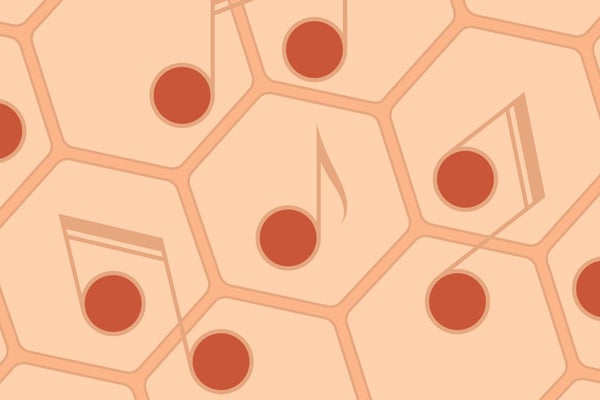Serenading Cells with Audible Sound Alters Gene Activity
Audible sound can affect gene activity in mouse cells, boosting the attachment of muscle precursors to surrounding tissue and decreasing fat accumulation

The cells in your ears aren’t the only ones listening: recent research suggests that crucial cells throughout the body may respond to audible sound. Experiments described in Communications Biology revealed more than 100 genes whose activity changed in response to these acoustic waves, pointing to possible medical applications.
Extensive earlier research has shown that ultrasound—sound at frequencies higher than humans can hear—can affect biology in numerous ways; the new study expands this concept to audible sounds that require no special equipment to produce. Kyoto University biologist Masahiro Kumeta and his colleagues bathed cultured mouse myoblast cells (precursors to muscle tissue) in sound, directly transmitting a low frequency (440 hertz, the A above middle C), a high frequency (14 kilohertz, approaching the top of the perceptible range for humans), or white noise (which contains all audible frequencies) to the culture dishes for either two or 24 hours.
The team analyzed the effect these sound waves had on the mouse cells through RNA sequencing, which measures gene activity. The scientists found that activity in 42 genes changed after two hours, and 145 responded after 24 hours. Most showed increased activity, but some were suppressed. “It’s a very extensive, thorough study,” says Lidan You, an engineer at Queen’s University in Ontario, who studies how bone cells translate mechanical stimuli into biological signals.
On supporting science journalism
If you’re enjoying this article, consider supporting our award-winning journalism by subscribing. By purchasing a subscription you are helping to ensure the future of impactful stories about the discoveries and ideas shaping our world today.
Many of the affected genes have roles in key processes such as cell adhesion and migration, which are known to respond to mechanical forces. The researchers found that sound expanded the size of the sites where cells attached to surrounding tissues, most likely by activating an enzyme called focal adhesion kinase (FAK), which senses mechanical forces and helps to guide tissue development. Sound waves seem to deform molecules in a way that provides easier access for a chemical switch that activates FAK, which in turn influences a chain of other genes’ activity.
The team also found a strong reaction in fat-cell precursors called preadipocytes: sound suppressed their differentiation into mature fat cells, thereby reducing fat accumulation by 13 to 15 percent.
Audible sound is noninvasive and probably safer than drugs, Kumeta says. Although it can’t be tightly focused like ultrasound, it is easy to produce and could be useful for bathing large regions of the body in sonic waves. Kumeta and his colleagues have already begun studying such interventions to suppress the development of fat tissue in living mice—and humans could be next, he says: “If it works well in mice I think this could be achieved in five or 10 years.” Other potential applications include enhancing regenerative medicine and combating cancer growth. “The next step [could be] using not only human cells but human organoids that model diseases,” You says, “then moving to clinical studies.”


1 Comment
9mr34e